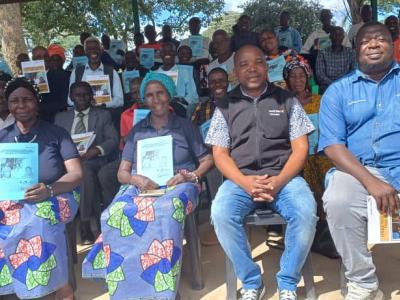article / April 15, 2025
Empowering Communities Through Citizen Voice and Action: A Path to Better Public Services in Chongwe East Area Programme
His Royal Highness Chief Bunda Bunda of the Soli people has applauded World Vision Zambia's Citizen Voice and Action (CVA) approach for transforming community engagement in Rufunsa District. Recognising the tool’s power to drive accountability and improve essential services, Chief Bunda Bunda hailed CVA as a catalyst for sustainable development in his chiefdom.
press release / April 4, 2025
Banteay Meanchey achieves Open Defecation Free status, transforming public health
A child is washing her hands at a handwashing station.
article / March 14, 2025
A New Era in Public Health Emergency Preparedness and Response in Zimbabwe
Zimbabwe has taken a significant step forward in public health emergency preparedness with the official handover of eight state-of-the-art Public Health Emergency Operations Centres (PHEOCs) by World Vision Zimbabwe to the Ministry of Health and Child Care (MoHCC).
publication / April 22, 2025
World Vision Malawi Gifts In Kind (GIK) 2024 Impact Report
Gifts In Kind Impact Report for World Vision Malawi
publication / April 22, 2025
World Vision Eswatini Gift in Kind (GIK) 2024 Impact Report
In FY24, World Vision Eswatini integrated over $2.3M in Gifts in Kind (GIK) resources—such as school furniture, medical supplies, and bicycles—into key programmes, boosting child well-being, health, education, and community resilience across vulnerable communities.
article / September 19, 2017
«Սկեսուրների դերակատարումը» և «Ինչպե՞ս տղա ունենալ»
«Սկեսուրների դերակատարումը» և «Ինչպե՞ս տղա ունենալ» միջոցառման ժամանակ ներկայացվեցին «Հոգտարություն հանուն հավասարության» ծրագրի շրջանակներում 2017թ.ին իրականացված «Սկեսուրների դերակատարումը և սեռով պայմանավորված հղիության արհեստական ընդհատումները Հայաստանում» և «Ինչպե՞ս տղա ունենալ.
article / December 17, 2024
Building healthier communities: World Vision Georgia’s impact on Public Health and awareness
The pandemic hit vulnerable families the hardest, including children, women, and people with disabilities. Many struggled with worsening economic and social conditions, leading to poor mental and physical health. Routine vaccinations dropped, and access to healthcare services became more difficult. To address these issues and support the recovery of public health, the organisation has launched its first major healthcare initiative, focusing on strengthening Georgia's health and child protection systems. Family doctors and social workers, were trained on key health topics such as immunisation, Hepatitis, HIV prevention, HPV, TB, and STDs.
article / April 23, 2025
Improving Access and Strengthening Support for Gender-Based Violence Survivors
A new Integrated Support Centre (CAI) in Murrupula, Mozambique, centralizes essential services for gender-based violence survivors. This initiative streamlines access to health, legal, and social support, overcoming the challenges of a fragmented previous system. The CAI is a collaborative project between the government and organizations, aiming to improve survivor support and address GBV. While acknowledging ongoing prevention efforts and some reported decrease in cases, the centre responds to the continued reality of violence. This unified approach is designed for sustainability and better care for survivors.







